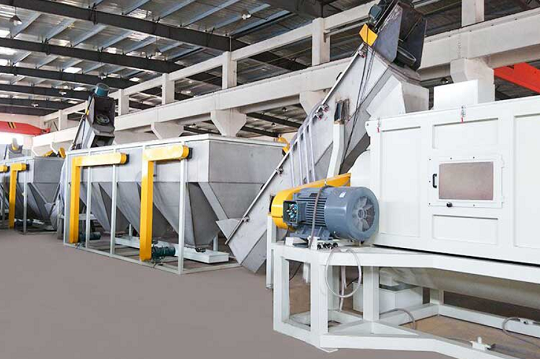© 2018 Zhangjiagang Sevenstars Machinery Co.,Ltd. All rights reserved. Site Map Designed by iwonder.cn privacy policy
Plastic recycling machine factory with 15 years experience
Plastic recycling machine factory with 15 years experience
Plastic recycling is a well-established industry that globally processes and resells several million tons of used plastic material each year. Rather than operating merely out of environmental necessity, plastic material recovery services can be both cost-efficient and productive, saving resources for a range of different manufacturing applications. The recycling and reclamation field also encompasses the industrial processes by which plastic materials are separated into their base monomers and made available for further polymerization at secondary and tertiary levels.
Sorting and grouping plastic materials according to resin type is an important first step in the recycling process because contamination can render a batch of material un-reusable. The most frequently recycled resins, including polyethylene terephthalate (PET), high-density polyethylene (HDPE), and polyvinyl chloride (PVC), must be carefully separated from one another in order to enable further processing. Contaminants within each type of plastic must also be removed from the base resin to ensure stock purity.
Sorting machines must rapidly identify and categorize large volumes of post-consumer plastic, often under continuous input. Although there are varying degrees of technical sophistication and capacity, an advanced sorting machine can be equipped with some or all of the following features:

Sensors: These devices detect specific polymers within a mixed stream of plastic materials. They can be equipped with x-ray or infrared sensing that registers a polymer’s unique signature along the spectrum. Some sensors also incorporate color detection technology that sorts material according to tint and transparency.
Ejectors: Mechanical or precision air ejection units physically group different plastic materials according to resin types. Depending on their capacity, ejectors can often handle very high rates of input.
Computing Systems: Computer processing technology supplies the algorithms that are used to identify and sort different materials. These systems provide the controlling parameters for both sensor and ejector operations.
User Interfaces: An operator’s interface can provide machine controls and diagnostic tools for technicians. In addition, interfaces can also offer networking abilities to help integrate a sorting machine and make rapid adjustments to its functions.
In a nutshell, yes and no. The plastic recycling process is fraught with flaws. Some dyes used in creating plastic products can be contaminated, causing entire batches of potential recycling material to be scrapped. Another issue is that producing recycled plastic does not reduce the need for virgin plastic. However, due to its use in the manufacture of composite lumber and many other products, plastic recycling can and does reduce the consumption of other natural resources, such as timber.
While it's true that there's still a large percentage of people who refuse to recycle (the actual numbers of plastic being returned for reuse is roughly only 10% of what is purchased as new by consumers), there are a lot of plastic items—like drinking straws and children's toys—that aren't considered recyclable at all.
In addition, over the last few years, overwhelmed by the sheer volume and rising costs, many communities no longer offer recycling options or have added restrictions (washing and drying containers, and disallowing certain grades of plastic) for items that could have been recycled in the past.
Plastic recycling has come a long way since its inception and continues to make strides in reducing the amount of waste in our landfills. While disposable packaging isn't likely to disappear altogether, a number of alternative options, including biodegradable cellulose-based containers, cling film, and shopping bags, as well as reusable silicone food storage solutions are becoming more readily available to consumers.
In some locations, consumers looking to lessen the plastics in their lives are looking to the past to inspire the future. Milkmen—and women—are making a comeback, delivering not only milk in recyclable glass bottles but organic fruits and vegetables along with artisan cheeses and baked goods. It can only be hoped that in the long run, the conveniences offered by our present "disposable society" will eventually be outweighed by conveniences that are actually good for the planet.